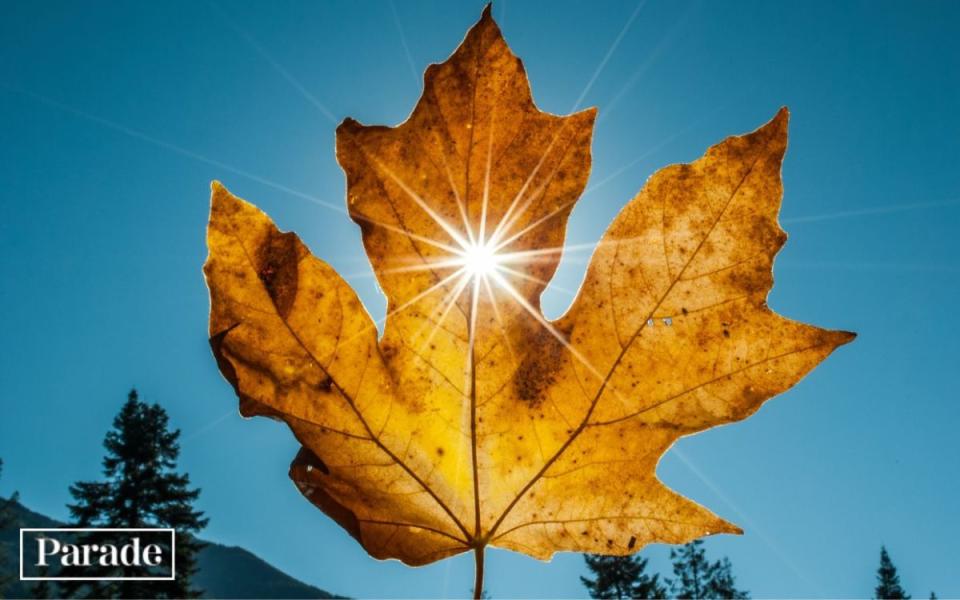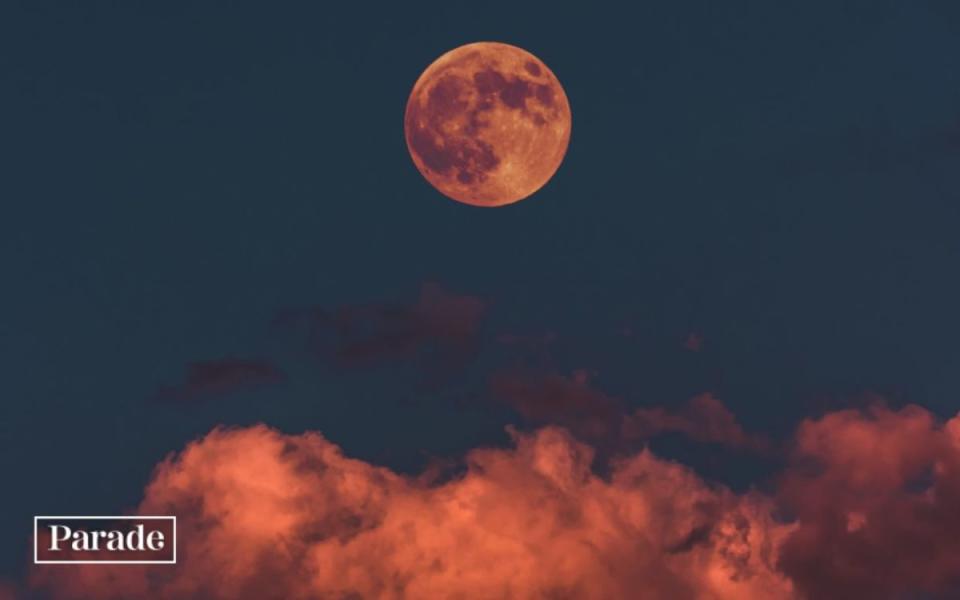All of the Fall FAQs—When Does Fall Officially Start? And What Happens During the Fall Equinox?

Autumn is synonymous with a lot of things. Like back to school, football season, Halloween and pumpkin spice everything. The days get shorter, the weather cools off, weekends are spent apple picking, and the leaves on the trees begin to turn glorious shades of orange, yellow and red. And while some of us start indulging in those beloved fall activities as soon as Labor Day passes—the long holiday weekend traditionally marking the end of the summer season—the first day of fall doesn’t actually come until later in the month of September with the fall equinox!
So when is the fall equinox? What is the fall equinox? Is it always the same date? Why is the fall equinox the start of autumn? When is the first day of autumn 2023? If those questions are running through your mind right now, we are here to explain it all in our primer on the start of fall 2023!
Here's everything you need to know about the fall equinox—what it is, what it means and why we celebrate it.
When Is the First Day of Fall 2023?
The official first day of fall is officially Saturday, September 23, 2023. But again, this is only for the Northern Hemisphere, since the Southern Hemisphere experiences the reverse, and this equinox begins their spring.
Related: September Holidays and Observances
Is the First Day of Fall Always the Same?
No, the first day of fall can change year to year since the date is not determined by the Gregorian calendar—but only within a day or two. The Fall Equinox is an astronomical prediction of when the sun will cross the equator, and that tends to occur between September 22 and September 23 on the traditional Gregorian calendar.
What Is an Equinox?
The word “equinox” comes from two Latin terms: aequus, which means equal, and nox, which means night. According to the National Weather Service, an equinox occurs two times times each year, making the amount of daylight hours in a day and nighttime hours in a day are about equal in length. This happens because the Earth’s axis is tilted neither toward nor away from the sun, so every latitude across the globe receives nearly an equal amount of daylight and darkness on that day since the sun is directly over the equator. So equinox means “equal night.”
The Spring Equinox usually takes place between March 20-21 and the Autumnal Equinox between September 22-23. During the equinox, the sun crosses over the line of the Equator, making daytime and nighttime approximately the same length across the Earth.

Justin Cron via Unsplash
What Is the Fall Equinox?
The fall equinox—also called the autumnal equinox—is the start of autumn in the Northern Hemisphere. With the autumnal equinox, the sun crosses the celestial equator moving south, signifying the start of the colder months of the year for the Northern Hemisphere. (And the warmer months of the year, or spring, in the Southern Hemisphere.)
When Is the Fall Equinox in 2023?
In 2023, the Fall Equinox will be Saturday, September 23, according to Almanac.com. Because the Fall Equinox is not a fixed day, but is rather based on an astronomical prediction, the date can change year to year. But it always occurs between September 21 and September 24. In 2024, the Autumnal Equinox for the Northern Hemisphere will be Sunday, September 22.
Related: 40 Gorgeous Fall Nail Designs
What Time Is the Fall Equinox 2023?
The autumnal equinox will arrive at 2:50 a.m. Eastern Time. The equinox occurs at the exact same moment across the world. But because of varying time zones across the globe, the date of the equinox may be one calendar day sooner or later, depending on where you live.
Is the September Equinox or the Autumnal Equinox the Same Thing as the Fall Equinox?
Yes, the Fall Equinox, Autumnal Equinox, and the September Equinox are all the same thing—in the Northern Hemisphere. What we call the Fall Equinox (or Autumnal Equinox) is the Spring Equinox for the Southern Hemisphere. So most astronomers opt to refer to the two equinoxes as the September Equinox and March Equinox rather than by a seasonal name.

Ju On via Unsplash
What Happens During the Fall Equinox?
During the Fall Equinox, once the sun crosses the equator, it is located more south in the sky. As a result, the Earth’s Northern Hemisphere is tilted further away from the sun, leading the months that follow to have fewer hours of daylight and colder temperatures. This is the time of year when Daylight Savings Time ends.
As mentioned above, the opposite takes place in the Southern Hemisphere with the September Equinox. As the Northern Hemisphere is tilting away from the sun, the Southern Hemisphere is tilting toward the sun, so the days get longer, and temperatures rise in the southern part of the world. That’s why Christmas happens in the summer in places like Australia! So for the Southern Hemisphere of Earth, the September Equinox marks the start of spring.
Related: 100 Of The Best Fall Soup Recipes
Is an Equinox the Same as a Solstice?
No, a solstice is different from an equinox—although a solstice is a precise astronomical moment that occurs twice each year as well. A solstice is the most amount of daylight time or the least amount of daylight time in a 24-hour period and depends on how the Earth is tilted toward the sun. The Winter Solstice usually happens around December 22 and is the exact moment that the sun reaches its southernmost point from Earth’s equator. And the Summer Solstice tends to be around June 21, the exact moment when the sun reaches its northernmost point, and the North Pole is tilting closest to the sun.
The summer solstice is the official astronomical start of summer for the northern globe, resulting in the longest hours of daylight in the year for the Northern Hemisphere. And as you can guess, the winter solstice is the official astronomical start of winter for the northern half of the globe and is the day with the most hours of darkness.
Related: Easy DIY Halloween Decorations

Altinay Dinc via Unsplash
How Is the Fall Equinox Celebrated?
Different cultures have celebrated the Fall Equinox for centuries. Since the September Equinox occurs in the autumn in the Northern Hemisphere and coincides with the fall harvest, many ancient harvest festivals take place around this time, according to History.com.
In Greek mythology, the September Equinox marks the return of the goddess Persephone to the underworld for four months, where she is reunited with her husband, the god Hades. During the time that Persephone is with Hades, her mother, Demeter (who didn’t approve of the union), was said to grieve her loss by leaving the earth cold and barren until the goddess returned to Earth in the spring.
The ancient Chinese Shang dynasty celebrated a successful fall harvest at the Harvest Moon (the name for the full moon that falls closest to the Autumnal Equinox) by making offerings to the moon. In today’s Chinese culture, the Harvest Moon Festival or Mid-Moon Festival is celebrated by lighting up the streets with lanterns (a symbolic beacon to a path to prosperity and good fortune) and gathering to watch the moon and give thanks.
Japanese Buddhists celebrate the holiday of Higan with both the Spring and Autumnal Equinoxes. During this week-long celebration, Buddhists will return to their hometowns to pay respects to their ancestors, since it is believed that the world of the living and the world of the dead become close during the equinox. The changing of the season from summer to autumn becomes a time for Buddhists to reevaluate and change their own practices to reach enlightenment. Higan translates to “the other shore” and in the Buddhist tradition, crossing over the mythical Sanzu River to the afterlife means that one has achieved Nirvana.
In Great Britain, people have been celebrating the fall harvest for centuries, with festivals typically taking place on the Sunday closest to the Harvest Moon. This tradition of celebrating an abundant harvest was the basis for early English settlers celebrating the first American Thanksgiving!
The modern pagan community celebrates the fall equinox with a festival called Mabon to honor the changing seasons. It is traditional for many Pagans and Wiccans to not only celebrate the gifts of the Earth, but give thanks and appreciation for all blessings, and share that abundance with others. Similarly, Native Americans in the United States also gave thanks to Mother Earth and celebrated the fall equinox with smudging ceremonies to purify their dwelling and soul in preparation for the sweet season ahead.
The ancient Mayans in Mexico constructed the Kukulcáan pyramid at Chichen Itza and gathered during both the spring and autumn equinox to watch the sunlight create shadows that appeared like a snake slithering down the steps.
The Fall Equinox is also a prime viewing time for the Northern Lights, also known as the aurora borealis. The beautiful, celestial lights that dance across the sky in places close to the Arctic Circle reach a peak for several weeks each September through the end of October, and then again around the time of the Spring Equinox in March. The northern lights are seen during geomagnetic storms, when electrically charged particles from the sun collide with the Earth’s atmosphere, causing them to glow in the sky. During the two yearly equinoxes, there are usually twice as many geomagnetic electrical disturbances in the Earth’s atmosphere. When combined with the tilt of the Earth’s axis, this provides a greater view of the Northern Lights.
While there is no official ritual in the United States, some may jokingly argue that the switchover from a summer wardrobe of tank tops and flip-flops to cozy sweaters and boots is itself a celebration of the Fall Equinox. So trade that iced coffee for a pumpkin spice latte and prepare for all the awesomeness that the upcoming fall season has to offer!
Next, read up on all of the holidays and observances celebrated in September 2023!

